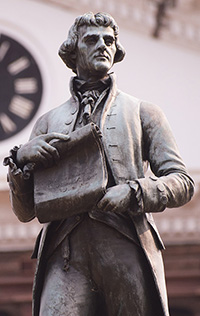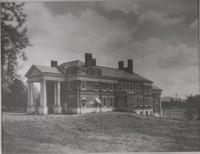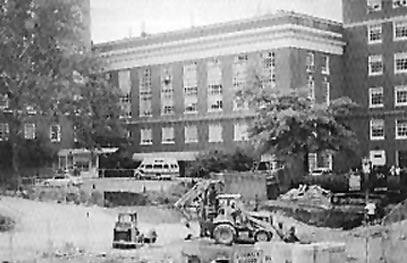History of Surgical Education at UVA
UVA Founded in 1819
Thomas Jefferson established the University of Virginia in 1819 according to his philosophical vision. For Jefferson, the college experience should take place within an “academical village,” a place where shared learning infused daily life. Plans were developed for ten Pavilions, stately faculty homes with living quarters upstairs and classrooms downstairs, attached to two rows of student rooms and connected by an inward-facing colonnade. Each Pavilion was identified with a subject to be studied and inhabited by the professor who taught that subject.
Origins of Surgical Education at UVA

Surgical education at UVA began in 1825 when Dr. Robley Dunglison came from England as the first professor of the Medical School, roughly one month before the first students arrived on campus. In 1828, the first medical school graduates received degrees, the first degrees granted by the University. The University recognizes this honor each year when the medical school graduates lead all graduates onto The Lawn at Final Exercises each spring.
In 1834, after four years as the first Demonstrator in Surgery, Thomas Johnson resigned. Dr. Augustus Warner became Professor of Anatomy and Surgery, a post he held for three years. In 1838, Dr. James Cabell (a nephew of one of the founders of The University, Joseph Cabell, for whom Cabell Hall on the south end of The Lawn is named) was appointed the first Chair of Anatomy and Surgery at the University and was the first of such chairs to be assigned a Pavilion (Pavilion II, adjacent to the Rotunda). Dr. Cabell was Chair of Surgery at least until Dr. Paul Barringer was appointed Professor of Surgery in 1886, and Dr. Cabell seems to have remained on the faculty for a few more years, for a total of about 50 years on the UVA faculty. Dr. Cabell still holds the distinction of being the longest tenured academician in an American medical school. Of note, Dr. Cabell was also among the founding members of both the American Medical Association and the American Surgical Association. It has been said that Cabell, at least during his lifetime, was one of the best known academicians to teach at UVA in its history. (For more on Dr. Cabell, one can refer to an article about his career published in The American Surgeon, available in the UVA medical library. One can also read more of the details of these early days of The School of Medicine at The University of Virginia in The Alumni Bulletin of 1914 which was written by John Staige Davis, available online).
In 1889, Paul Barringer was appointed Chair of Surgery, and Richard Whitehead was appointed Demonstrator of Anatomy, which was the first time these two positions had been separated at The University. Dr. Barringer’s appointment is considered to mark the beginning of the ‘modern era’ of the Department of Surgery.
UVA's First Hospital
 In 1886, the first hospital opened in Charlottesville called The Piedmont Hospital. Dr. Barringer foresaw the need for health facilities and worked diligently in fund raising and architectural planning for a modern hospital in Charlottesville.
In 1886, the first hospital opened in Charlottesville called The Piedmont Hospital. Dr. Barringer foresaw the need for health facilities and worked diligently in fund raising and architectural planning for a modern hospital in Charlottesville.
Construction of the present University of Virginia Hospital started in 1900 and the first wing was completed in 1901 at a cost of approximately $50,000. In 1903 and 1907, the University added the south and north wings of the original hospital, respectively. In 1907, Dr. Steven Hurt Watts became Professor of Surgery and Gynecology. Dr. Watts was the first chairman in the modern era of surgical education at UVA. He graduated from the Johns Hopkins Medical School in 1901 and received his surgical training under William Halsted. Dr. Watts headed the Department of Surgery and Gynecology for 21 years before he retired in 1928.
Growth and Expansion
 Dr. Edwin P. Lehman was Professor and Chair of Surgery from 1928 to 1953. During that time, Dr. Lehman continued to recruit faculty and expand the hospital. In 1954, Dr. William H. Muller, who had trained at Johns Hopkins under Alfred Blalock, came from UCLA to chair the department. During his tenure as Chairman, the hospital and Medical School essentially doubled in size with the addition of a new multistory building and library space within the Medical School. Dr. Muller’s chairmanship at UVA culminated in his appointment as Vice-President for Health Affairs as he oversaw the construction of the present University of Virginia complex and the development of the Health Sciences Center. Dr. Muller was president of the American College of Surgeons in 1976.
Dr. Edwin P. Lehman was Professor and Chair of Surgery from 1928 to 1953. During that time, Dr. Lehman continued to recruit faculty and expand the hospital. In 1954, Dr. William H. Muller, who had trained at Johns Hopkins under Alfred Blalock, came from UCLA to chair the department. During his tenure as Chairman, the hospital and Medical School essentially doubled in size with the addition of a new multistory building and library space within the Medical School. Dr. Muller’s chairmanship at UVA culminated in his appointment as Vice-President for Health Affairs as he oversaw the construction of the present University of Virginia complex and the development of the Health Sciences Center. Dr. Muller was president of the American College of Surgeons in 1976.
In 1982, Dr. R. Scott Jones came from Duke University as the Stephen H. Watts Professor and Chair of the Department of Surgery. During Dr. Jones’s tenure, surgical education at UVA continued to grow. Programs developed a rapport of excellence, including cardiothoracic, vascular, oncology, and general surgical with specific emphasis in gastrointestinal disease. Additionally, many new programs, including the development of a Level I Trauma Center, critical care programs, solid organ transplantation and endocrine surgery developed and have continued to grow.
Into the 21st Century
 Surgical education at UVA continued when Dr. Irving Kron became the seventh Chair of the Department of Surgery on January 1, 2002, continuing a remarkable tradition of stability in the department. Dr. Kron received his general surgical training at Maine Medical Center and cardiac surgical training at UVA. The NIH and American Heart Association has funded his laboratory for fifteen years.
Surgical education at UVA continued when Dr. Irving Kron became the seventh Chair of the Department of Surgery on January 1, 2002, continuing a remarkable tradition of stability in the department. Dr. Kron received his general surgical training at Maine Medical Center and cardiac surgical training at UVA. The NIH and American Heart Association has funded his laboratory for fifteen years.
Dr. Jones was President of the American College of Surgeons from 2002 to 2003. Dr. Edward Laws from the Department of Neurosurgery was President of the American College of Surgeons from 2006 to 2007. Dr. Muller was president of the American College of Surgeons in 1976, making UVA one of the few academic centers in the world to have three faculty members serve as president of the College.
